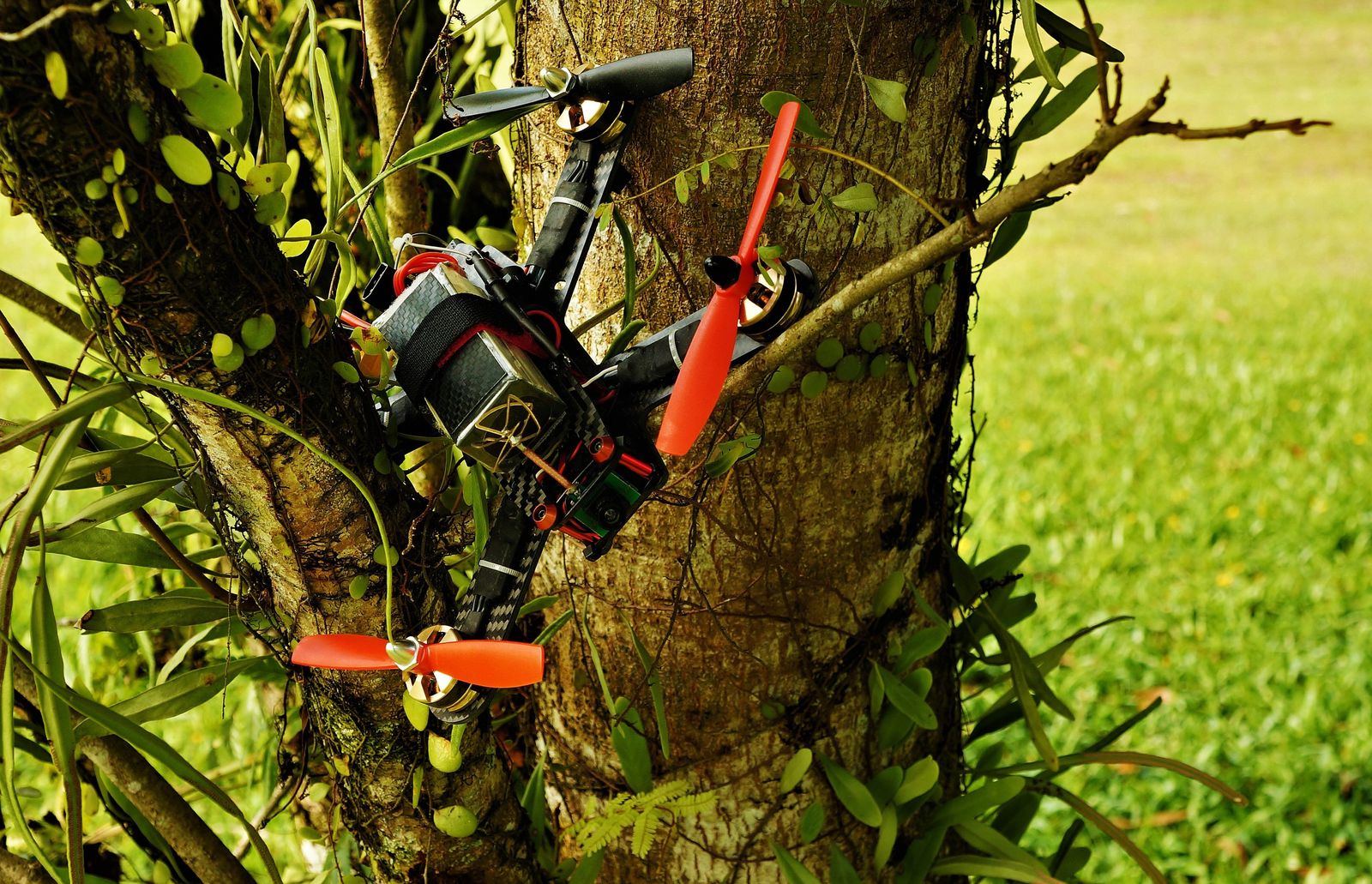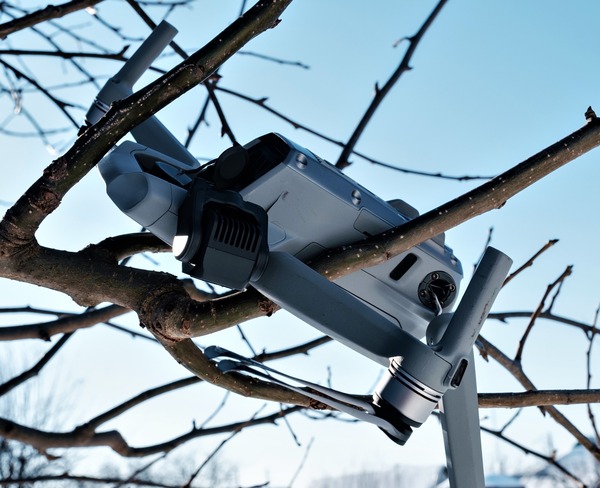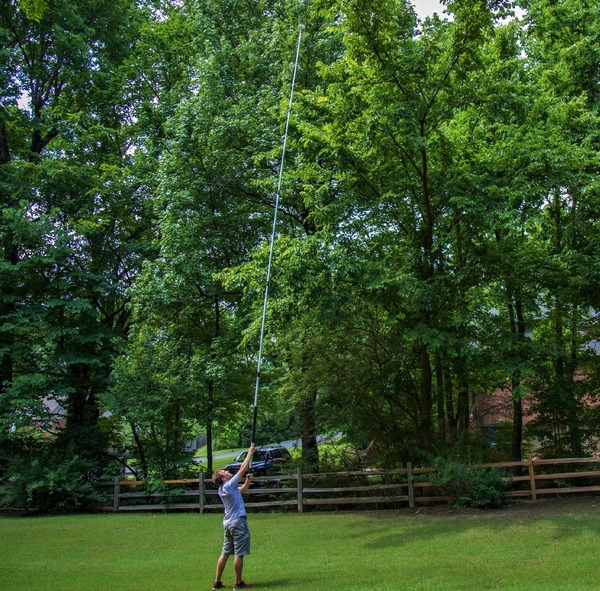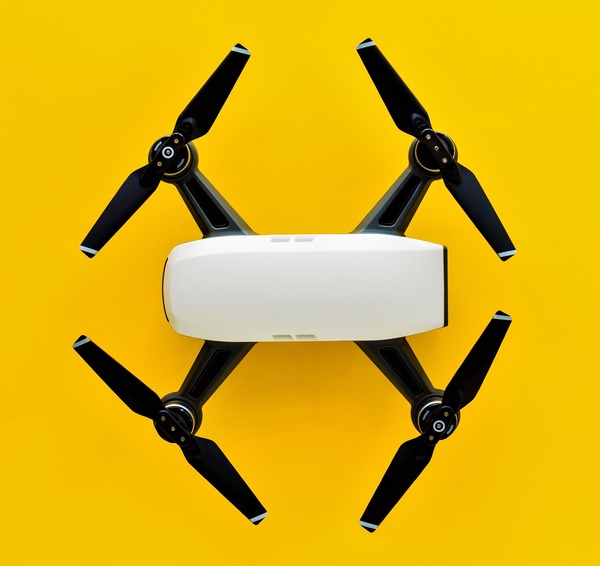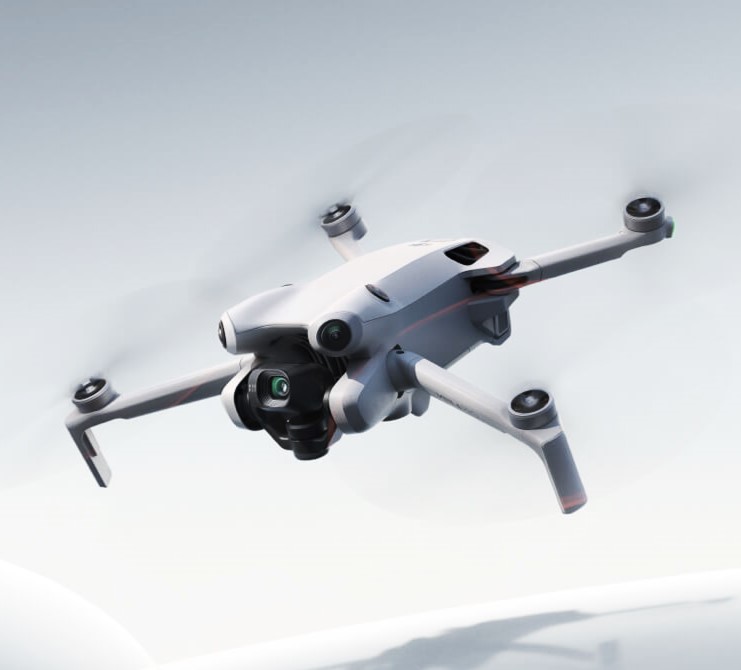We’ve all heard the story of Icarus, who flew too close to the sun and met his untimely downfall.
Stepping out of the realms of myth and into the inconveniences of reality, the truth is that we all can fall victim to this situation ourselves. Unfortunately, except in the modern world, this miserable situation presents itself not as melted wax wings but as our favorite possessions, be they pets, kites, or, in the present time, even expensive drones.
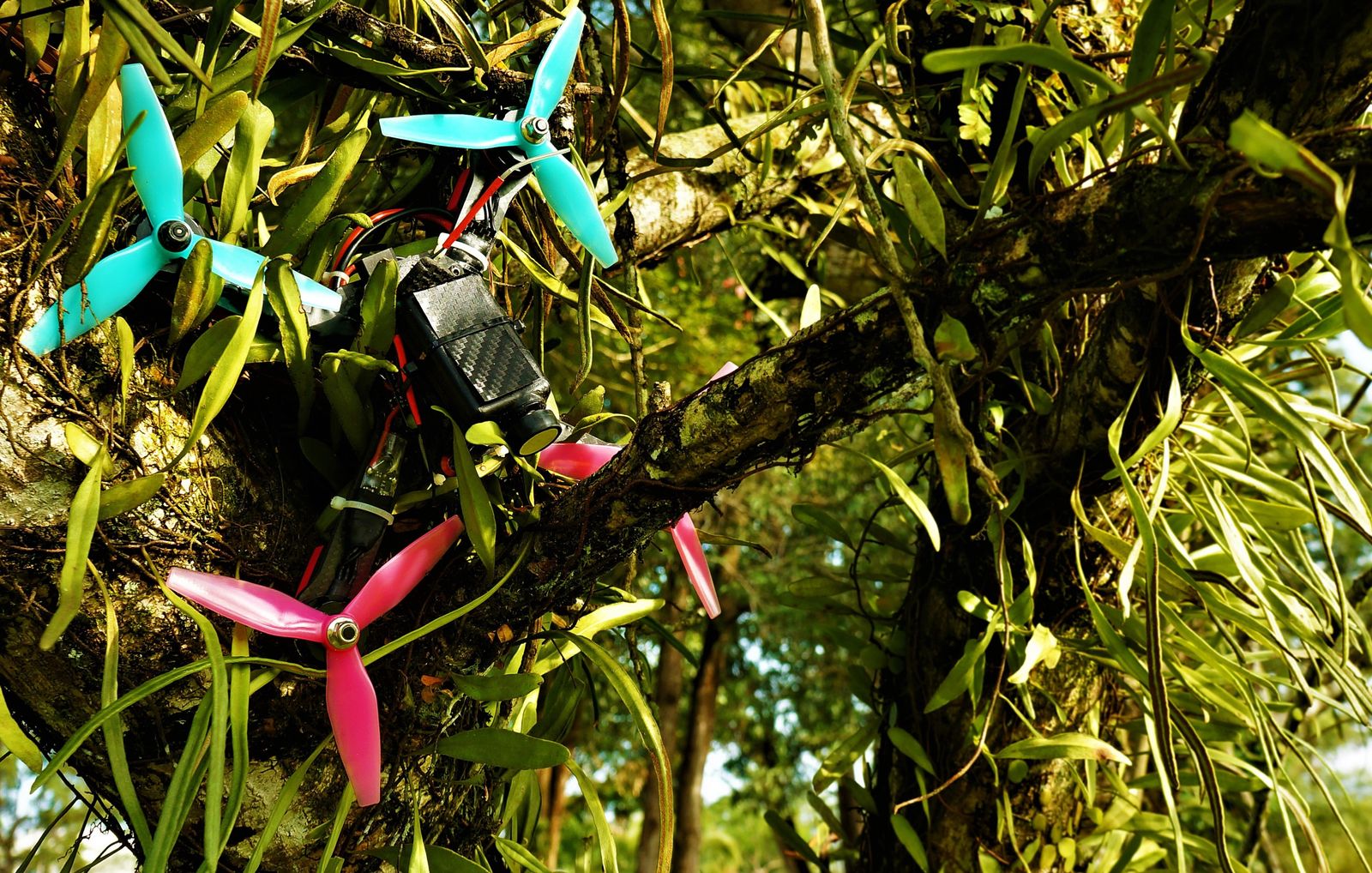
We know you were in the midst of an exciting and fun-packed day flying your dearest drone around your local wooded area. So what could possibly go wrong on such a perfect day as this? Whizzing across the landscape, trees, and sky alike, nothing but a thought, forgotten immediately, that they are out of sight in a second.
You have nothing to worry about but your fantastic drone and a sky full of promises. Until the unthinkable happens. Both your drone and good mood come to a halt, and you find it stuck in a tree.
Whether that has been the result of a malfunctioning remote control, an unseasonably windy day, or even just the understandable overexcitement of playing with your new exceptional UAV for the first time, it is certain that all of us at one point have flown too high and found ourselves stuck in a tree.
Understandably, your first reaction is to get it back safely in your hands as fast as possible. But think carefully: this is not a situation to be taken lightly. Damage to both you and your drone may ensue if proper precautions are not taken.
Take a deep breath, read this article, and then determine the best option for the safe retrieval of your prize possession. With helpful tips and tricks, insightful do’s and don’ts, and the detailed list of easy options mentioned below, you will soon have your drone flying for fun, filming, or adventure once again.
So, without further ado, let’s get to work getting your drone out of that tree!
Simple Ideas – No Equipment Required
Let’s start by first thinking about what tools you have. If the answer is none, fear not! Here is the perfect list of options for manual retrieval.
1. Fly Your Way Out
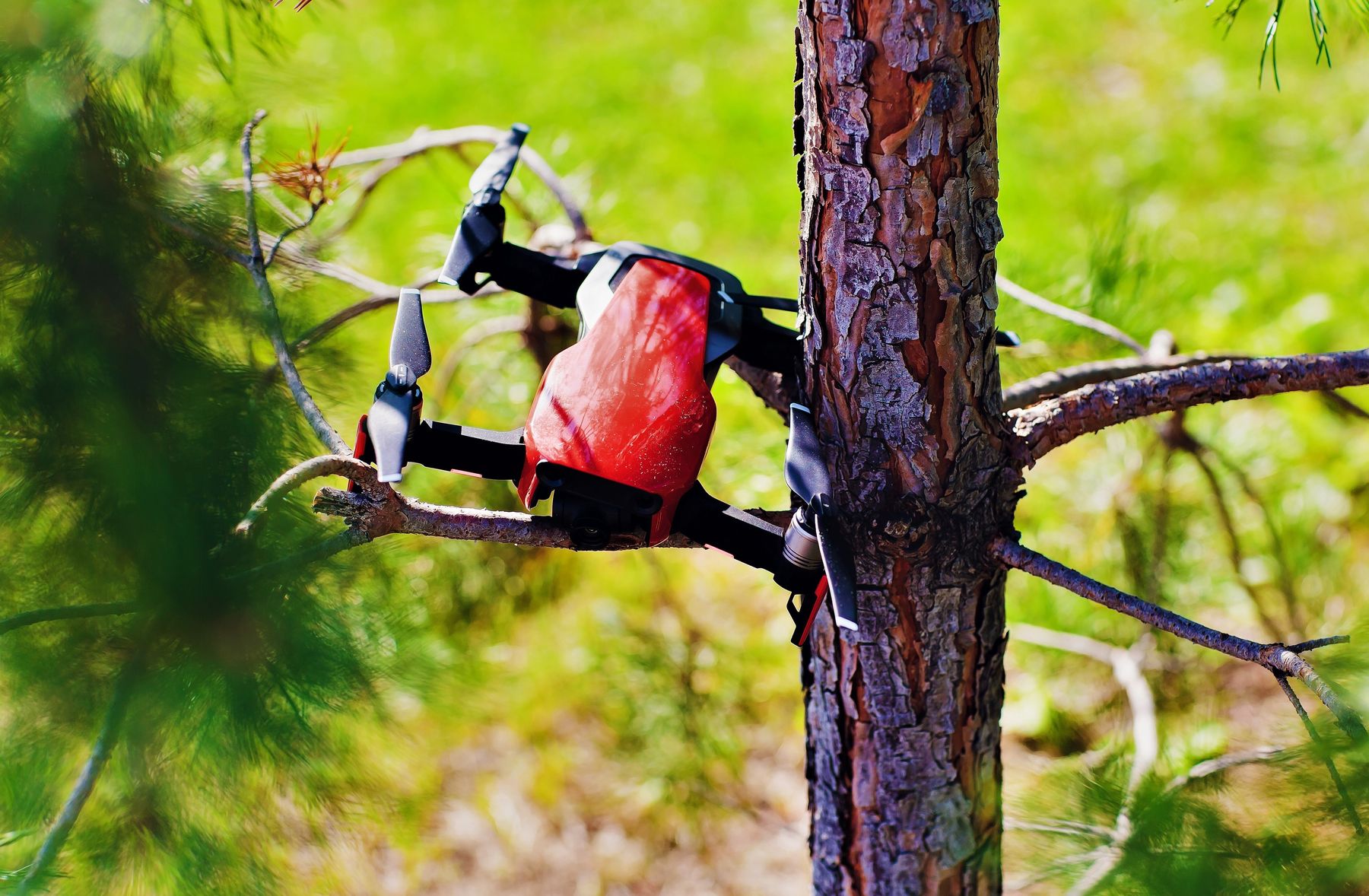
The most important thing is to remember there is always hope. The situation may not be as dire as first expected- in fact, the drone may not even be stuck at all. No tools or other options will be required if this is the case.
Have you tried to fly the drone out of the tree yet?
If not, it’s understandable. It can be a reason to panic just seeing your drone getting stuck in a tree in the first place and looking up solutions before you try anything that may cause more damage.
First things first, inspect the scene: Can you see your drone? If you can’t see it from your vantage point, can you stream the drone’s FPV camera to your phone to get a good look at where your drone is located and exactly what is surrounding it?
If the answer to either of these questions is yes, pay close attention to where the propellers are in regard to the branches or leaves.
Suppose they are tangled within the propellers or perilously close to the propellers (which may obstruct their movement). In these circumstances, you may skip this option as it may result in the drone becoming further lodged into the tree, or you may end up damaging the rotors in the process of trying to fly out.
Can you see a clear flight path from the tree if your propellers are not stuck in or close to the branches? If you can, and your drone still has sufficient battery power left, you can give it a shot to bring your drone back safely to the ground using your navigation skills.
Ensure you know how high to lift the drone and in what direction it needs to fly to become dislodged.
Once you are sure of what you will be doing, attempt to fly the drone out of the tree. If you can’t fly it out, try moving the propellers in different directions to see if the movement can help shake your drone loose.
But pay close attention: If your drone is stuck very high up in a tree, it could be a good idea to crank up the rotors if it starts falling (once clear of the branches, of course) so you can recover mid-fall rather than having your drone fall all the way to the ground. Remember, falling directly from the sky will result in much more damage than the other options for rescue listed below.
2. Shake the Tree

This easy and safe option to shake the drone from the tree is very situationally dependent.
Shaking your drone loose may be an excellent option if you are dealing with a very thin trunk tree. However, even with a thin trunk, if your drone is stuck too high up in the tree, it may take some serious muscle to cause movement high enough in the tree to make a difference.
On the other hand, if you are dealing with a tree that has a thick trunk (more than one foot wide), this option may not work for you as the tree may be too rigid and immovable. Nevertheless, it’s always worth a try. In such conditions, friends are a great option. So do ask yours to come over and lend a helping hand!
The process is self-explanatory. Grab a steady grip on the tree and shake it back and forth, applying as much force as needed to produce the movement required to free the drone and make it fall off the tree.
Note: When performing this drone rescue attempt, ensure you (or any of your friends) are not in the line of fire by standing directly underneath the drone. If it falls, it can cause you serious harm.
Another thing to note, on top of your own safety, is the safety of surrounding wildlife. So make sure that by shaking your drone free, you are not causing damage to any animal habitats in or around the tree.
If there is a bird’s nest, squirrel, or any other type of animal located in the same tree that your drone is stuck in, leave the animals alone and move on to the next possible solution.
Tip: Remember that drones and gravity are mortal enemies. Shaking the tree that the drone is in may result in it becoming dislodged- Yay! And falling onto the solid ground, becoming damaged- Boo!
To prevent this short-lived happiness from turning into a disaster, assess the area where the drone is likely to fall if you succeed in shaking it out of the tree. After this, line it with cushioning using pillows, blankets, mattresses, or something else soft to help prevent damage upon impact. Or consider having someone prepared to catch it before it hits the ground.
3. Climb the Tree
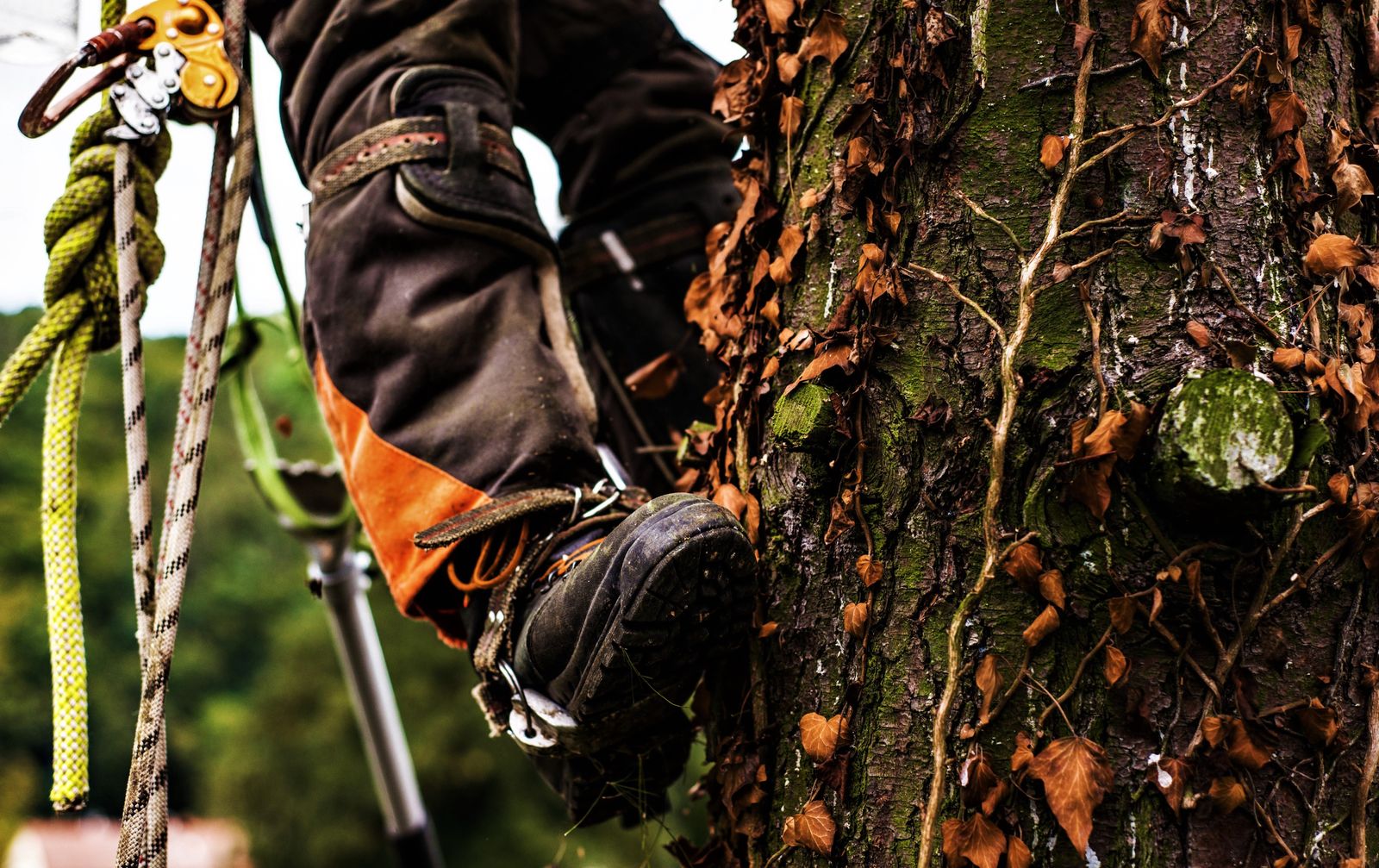
Warning:
One important fact to mention is that climbing trees is not recommended for amateurs. There are safer options that should be used first to retrieve your drone, especially if the drone happens to be lodged further up the tree or is stuck very far out on the branch.
Climbing trees can be dangerous, particularly for those who are elderly, pregnant, or have long-standing injuries.
Proper safety precautions and equipment are always recommended, especially if the tree is wet or slippery. After all, a drone is easier to replace than a broken arm.
Before climbing, ensure the tree can support your weight and has the right branches to allow you to climb with relative ease. It is also paramount that you make sure you are not breaking any laws, such as trespassing or protection orders on the land or tree that you are about to climb.
As always, friends are great companions for drone flying fun, but also, as a safety precaution in situations like this- utilize them and get them to assist (if needed) and ensure your safety should something go wrong.
You can never be too careful when dealing with heights, and remember, it’s only a drone and not worth serious injury.
As a part of the climbing process, the first step in safely planning your route up the tree is to make sure you also have a safe and clear way back down the tree.
Make sure the tree has strong branches to carry your weight and that you can get an adequate grip on the surface of the tree’s bark. This may be helped by climbing barefoot, or if you have a climbing rope, it would be pretty helpful to use that during your climb to keep yourself attached to the tree.
Always take your time when climbing trees. Ensuring that you can reach the branches you are trying to get to with ease. Focus on the strength coming from your legs and upper body.
The moment you reach the place where the drone is stuck, try to free the drone by gently pulling it out of the branches. Once retrieved, take your time and steadily climb your way back to the ground.
Note: Keep in mind that when you are climbing the tree, you have removed any jewelry or valuable items from your body or pockets that may be harmed or broken if they slip out while you climb.
Necklaces and rings can be especially dangerous when climbing, as they can catch on to something if you fall and cause great harm. Additionally, make sure that your attire is not very loose so that it doesn’t get stuck with any branches during the climb.
Tip: If the tree belongs to you and is on your property, you can avoid some of the physical hassle caused by climbing by creating a makeshift ladder. To do this, nail a few short planks of wood onto the trunk of the tree.
From here, you can climb up these planks like a stepladder to reach the drone or, at the very least, reach some of the higher branches to begin your climb. But, of course, this option is not available and may be illegal if the tree does not belong to you or is growing in a public area.
Another tip to ensure the easy and safe removal of the drone is to bring a backpack with you on your climb to put the drone inside once retrieved.
This will allow you to climb down from the tree using both hands, as attempting the descent with only one free hand could be very dangerous and can lead to falling and injuries.
More Demanding Solutions – Equipment Required
If you find yourself in a trickier situation where you can not complete the task of rescuing your drone without a tool- that’s fine. Don’t panic!
Perhaps the drone is trapped too high, or the tree is simply unshakable and not fit for climbing. In that case, here is a list of alternative options for safely reuniting with your drone once again.
1. Use a Ladder
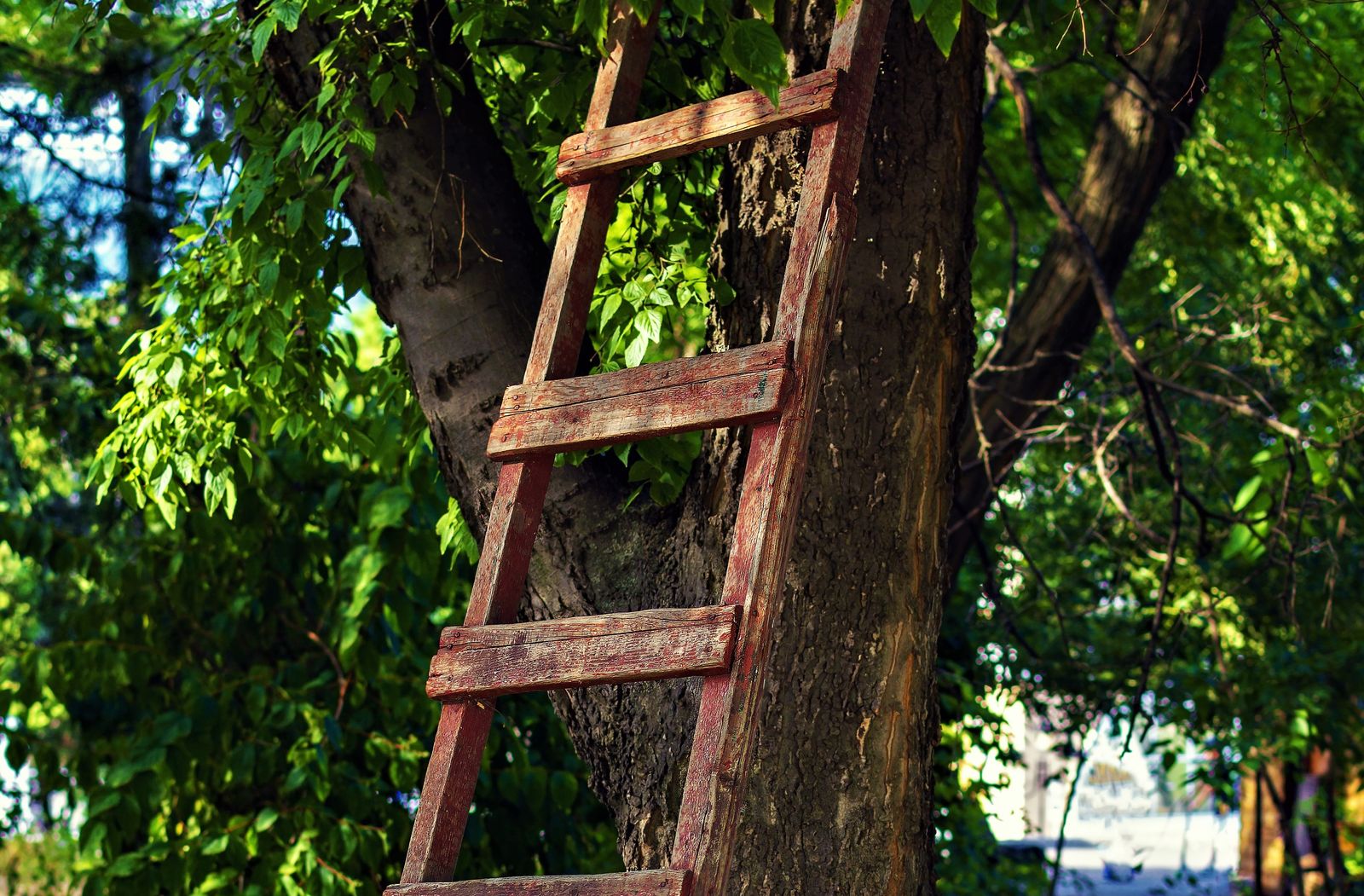
A great benefit of using a ladder is that a ladder is a staple household tool and will most likely not be in short supply between you or your neighbors.
This method of retrieval also allows gentle removal of the drone from the tree, preventing possible scratches or damage that may have occurred to it via other methods.
Using a ladder to retrieve your drone is a simple process:
- Place your ladder against the tree.
- Climb up and retrieve the drone.
- Then, climb down.
If you choose to try this option, first make sure that the ladder is in usable, sturdy condition, and long enough to provide you with the right height to reach the drone.
Also, it is vital to check the strength of the tree to ensure that the trunk or branches are strong enough to lean the ladder and your own weight. Just in case the tree looks half-dead or rotted, there’s a good chance it or one of its branches may break as you climb, leaving you with serious injuries.
If the tree or ladder’s condition appears to be not sufficient, other methods are recommended to ensure your safety.
Other Ways to Utilize a Ladder in Retrieving Your Drone
-
Climbing Using a Ladder
Maybe climbing the tree seems like your best option, but it’s made difficult by the lack of low-hanging branches at the base of the tree. Or simply, the ladder isn’t tall enough to get you to your drone but is high enough to get you to the sturdy branches. No worries!
Simply combine the two methods of ladder and tree climbing for a more productive result.
Use the ladder at the base of the trunk, following the same safety precautions as before, to reach the higher branches and climb from there.
-
Ladder Shake
If the tree branches are thin, somewhat flexible, and moveable, they may snap against the ladder and your own weight.
In such a scenario, we are already familiar with the fact that your ladder cannot get you to where the drone is directly, but still, it can get you close enough to grab and shake the branch (or the branch nearby) in which your drone is stuck.
For this option, the first thing you need to do is place the ladder against the tree trunk. Next, climb the ladder and reach the branch where the drone is stuck. Now, grip the branch firmly and move it back and forth to create a swaying motion that will hopefully dislodge the drone from the branches.
Note: Safety precautions when attempting these methods include ensuring the ladder is placed firmly on flat ground where it is unlikely to slip or fall.
Climbing a ladder, especially when its feet are on grass, dirt, or any other uneven surface rather than solid, flat ground, can be dangerous, especially without someone to ensure the feet do not slip.
It is doubtful that the tree your drone is stuck in is growing out of concrete, which means the ground on which your ladder will stand is likely uneven.
In circumstances like this, particularly when you have no one at the base to hold the ladder, we recommend using an A-frame ladder as it is prone to far more movement when being climbed than ordinary or extendable ladders and can reduce the risk of slips and falls.
Tip: As with the “climbing the tree” option above, a backpack or some satchel that you can attach to your body could be very handy when using a ladder to retrieve your drone.
Doing this will allow you to keep your hands free while climbing down, as you can place the drone inside the bag rather than having to hold it as you climb down.
Having both hands free is just as important when climbing down a ladder as when climbing down branches, so don’t forget to strap that bag to your back before you climb to get your drone.
Another great option is to include your friends again. Let them ensure your safety by steadying your ladder and being available to call for help should you, unfortunately, sustain an injury during the process.
2. Use a Long Pole
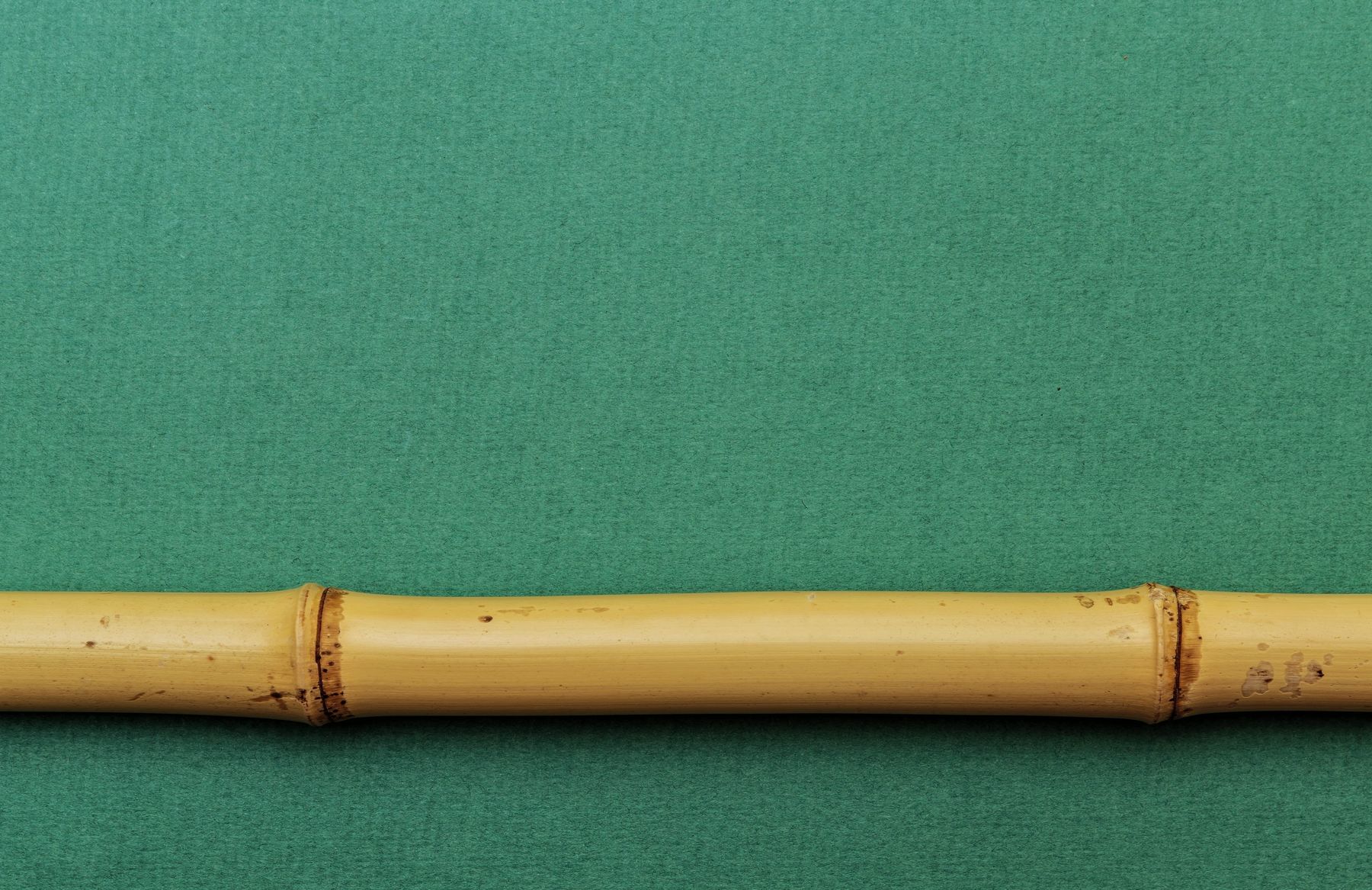
A long pole is another valuable and likely item you or a neighbor may have around the house or garden that can be utilized to help rescue your drone.
This method will allow you to remain safely on the ground while also returning the drone to safe ground without the risk of getting further tangled amongst the branches of the tree.
The process may sound a lot easier than it is, depending on what resources you have available, how steady your hand is, and how high up your drone is in the actual tree.
To keep this method as safe and effective as possible, the most appropriate type of material that makes the pole for this purpose should be light, firm, and inflexible.
A lightweight pole is imperative when reaching up onto the trees because the higher the pole is required to reach the drone, the higher the level of strain on your arms, and thus, the heavier it will feel. At further heights, the pole may also begin to bend and flex, increasing your difficulty in keeping its direction under control.
One of the best types of poles for this purpose would be made from bamboo, as this is lightweight and inflexible. Besides this, it is also easily accessible and inexpensive.
It’s very likely you or a neighbor will already have multiple bamboo poles in their garden, as they are popular and widely used gardening poles. However, if this is not the case, there is no need to worry; they can easily be found at any local garden center.
Another formidable option is a fiberglass pole, though these may be harder to come across. However, if one is accessible to you, this may be the best for this piece of work as it is robust, inflexible, and extremely lightweight.
Other types of simple household items that may effectively get the job done if they are easily accessible and long enough to reach your drone include a sweeping broomstick, multipurpose telescoping pole, pool cleaning pole, pool cue, wooden pole, a light bulb changer pole (yes, that is the technical term), etc.
If you don’t have any of these tools handy, the best time-effective method would be to visit your local hardware store, where they will undoubtedly have one of these or another form of the long telescoping pole that can help retrieve your drone, or you can as well order one for yourself online with “Same Day Delivery” option after going through the reviews.
Once you have your super-pole, you must raise it onto the tree to reach the drone. Ensure you have a firm grip on the pole to prevent it from swaying out of control as it ascends.
However, once the pole reaches the branches, it should become much more stable and easier to maneuver because threading it through the branches will help it gain the structural integrity and strength needed to keep its movements under control. Next, move it in the necessary direction to poke the drone out of the tree.
Once you reach the drone, apply a gentle force to nudge it from the tree, as a too-forceful poke may result in denting or scratching on the surface of the drone.
You can also simply hook the pole onto the propeller guards or landing gear as it won’t let the drone fall to the ground and try to give a slight shake to untangle the drone from the branches.
If this doesn’t work, you can just try using the pole to move around the branches that the drone is caught on in order to bring your drone back to the ground from the arms of the tree.
Easy Hack
Suppose your drone is stuck too high, and the pole available falls short of its needed length and can not reach the drone.
In such a case, there is no need to spend your hard-earned money to purchase multiple (depending upon the height) expensive telescopic poles that will end up lying somewhere around the corner of your house and never see the light of day again after this one use.
A much better option financially is to build your own setup for half the cost of one telescopic pole using ABS pipes. Your local hardware store likely carries these types of pipes in various lengths, as they are often used in several kinds of industries.
When it comes to set up, you can purchase a number of 1.5-inch thick ABS pipes of 10 ft. length (standard size) sections needed to achieve the required height at which the drone is stuck, along with the connecting pieces and duct tape.
To avoid injury or inconvenience, we recommend cutting the pipes into five-foot-long sections using a hacksaw and carrying them out to the tree, only attaching them together when you have reached the area where the constructed pole is needed.
Doing this makes the whole setup more manageable to carry rather than one long, cumbersome pole. To make carrying even easier, you can invite your friends to help!
Once you have reached the scene of the incident, combine those multiple pipes into one long pole. To do this, lay them end to end and attach them with connectors and tape. Now, you have your own newly constructed pole ready to dislodge the drone from the tree using the procedure mentioned earlier.
After successfully retrieving your drone, the pole can be dismantled section by section by carefully removing the duct tape and joint pieces.
You can carry the setup home and store it in a safe manner should such an event ever reoccur in the future, or else, if you want, you can list the pipes online for sale at 20-30% less than the cost you paid to get your money back.
This DIY hack is all about ingenuity, and different types of pipe and pole materials could be used instead of those suggested above.
You have to analyze the situation and act accordingly. For example, suppose the abs pipe is not available. In that case, a thick PVC pipe can be a good alternative, or if you are a northerner, you can assemble a few snow roof rakes together to create a long stick (You can also borrow from your neighbors depending upon the height at which the drone is stuck) or else you can use whatever it takes to get the size required to reach your drone.
Just make sure to avoid flexible or heavy poles generally found at the local hardware store, as these will be far too difficult to maneuver through high tree branches.
Alternative Option
-
Using a Pole and Ladder Combination
A helpful method may be to combine two of the previously mentioned options. For example, if you find the drone too high up to reach on the ladder alone or find the long pole too hard to control at such heights, combining both methods may be your saving grace.
Climbing a 15ft ladder armed with a 10ft pole and including your own size could allow you to reach over 30 ft of height onto the tree!
A necessary safety precaution to keep in mind is that maintaining balance on a tall ladder with a precarious pole may be difficult. Slipping or falling from high up on a ladder could result in injury. Therefore, it is always recommended that you have a friend join you to keep the ladder’s base steady and to ensure you do not injure yourself.
Note: Safety is of the utmost importance when attempting any of these retrieval methods, but especially here. Before beginning, ensure that there are no power lines nearby that your pole may interfere with.
Always make sure your pole is made from a non-conducting material and should not come into any contact with overhead power lines, as this could be a hazardous proposition. If you don’t believe us, read this article to help you understand the danger involved when dealing with power lines.
Take your time. Remember that your safety is a priority over your personal belongings. Keep in mind all safety precautions to ensure a safe, productive, and positive outcome.
If, in case, there are power lines present and touching the tree, the best would be to look out for other alternative methods, as there are plenty of options still available to try, and life is far more valuable than any drone!
Tip: If you are worried about the occurrence of scratches from the pole on the surface of your drone when poking, it is recommended that you cover the end of the pole with a soft fabric like a rag or t-shirt, or something else. Doing this will prevent any scratching and give a softer push when the pole makes contact with your drone.
It’s a great idea to enlist the help of a friend to catch the drone should it fall. If not, placing soft padding around its landing area to break its fall could keep your drone from breaking upon its crash to earth.
Another idea that would ensure the safety of your drone is to create a 90-degree bend in a fishing net and tape it near the top of the pole, creating essentially a very long butterfly-catching net.
This way, you have a catching basin for the drone to fall into, thereby preventing it from falling to the ground and potentially causing harm to you, itself, or anyone else watching.
3. Use a Fishing Line

A fishing line is a different option you could try.
A strong kevlar-coated line is a sturdy and trusty tool for this job. Pair this with a weight (it’s better to use something soft but heavy – as simple as a baseball, cricket ball, or a ball made of old socks), and you have everything you need!
Start by attaching the weight at one end of the fishing line, ensuring it is correctly tied up and will not fall off when thrown. Next, carefully unwind the fishing line, and avoid tangles as you create a straight line leading to more than twice or thrice the length of the estimated distance of the drone from the land.
Now, throw the weighted end over the branch on which the drone is entangled or one near it (right above or below), but avoid hitting the drone, as, after all this effort, it would be a real shame to end up destroying your UAV and bring it all entirely crashing down.
After this, you should have formed a convex curve or lowercase ‘n’ across the branch.
If you feel like the angle or branch you have managed to obtain is unsatisfactory and will not result in the eventual release of the drone, you can cut the line, reattach the weight, and try again. Practice makes perfect!
If the fishing line does not seem to reach a high enough branch, try attaching a heavier weight or even using a bow and arrow by tying the fishing line to an arrow and shooting it over. Furthermore, you can also use a slingshot to fire the weighted end of the line above the appropriate branch or even create your tree recovery system using the instructions in the video below.
Here’s a Video Walkthrough of Making Your Own Tree Recovery System:
From here, you must shake the fishing line in order to shake the branch and allow the drone to fall onto the cushioned surface below.
Suppose the branch happens to be particularly stubborn and unmoving. In that case, there remains the option to hoist up a paracord, a thick rope, or just anything strenuous by attaching it to the end of the fishing line and pulling over to add more shaking force to the stronger branches to cause enough movement to dislodge the drone.
Note: Make sure that you secure the end of the fishing line at ground level before throwing the other weighty end over, or else you risk wasting the perfect shot.
Do pay attention to your position, the position of your friends, and the surroundings in relation to the trajectory of your throw. Face towards the direction in which the object’s trajectory is unlikely to hit any person or anything else. Besides this, ensure that no one is standing directly beneath the drone as they have sufficient weight and enough sharp parts to cause serious injury when dropped from a height.
On the off chance that you are in a public area, ensure everyone around gets a fair warning about the falling drone so they stay out of the way.
Tip: Don’t concentrate all of the movement on one section of the line, or you will run the risk of breaking it (due to friction). Instead, keep threading different parts of it over the branch to keep it intact.
Moreover, the fishing line can do a lot of damage to your hands if not appropriately handled, or just in case the correct trajectory takes multiple attempts to be achieved. So, to safeguard your hands from cuts, friction burns, or general irritation from moving the line, protective gloves may be a worthy investment!
4. Use an Aerial Work Platform
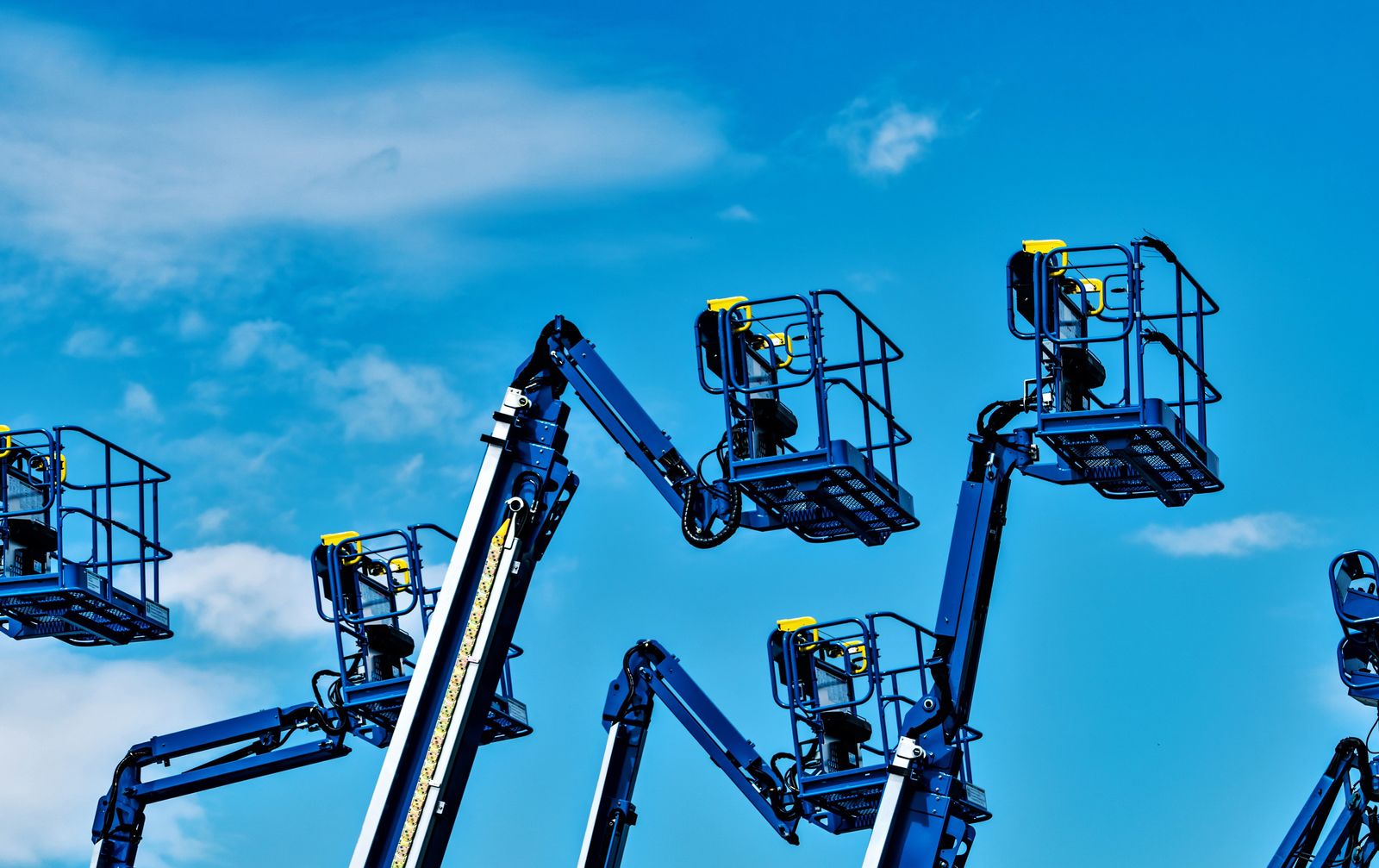
If none of the above-listed methods work, hiring an aerial platform and the qualified and licensed person required to operate it is also an option.
However, before divulging into your new $200 or more project, consider whether this is a financially viable option for yourself.
It may be that, at this point, the battle is lost, and the forest now has a new toy. After all, hiring an aerial platform for $200+ to rescue a $100 drone doesn’t seem like the most logical of purchases.
However, if the drone is either expensive or exceptionally sentimental to you, you may wish to continue, so let’s ensure you have the best information to proceed.
Read more: How to Buy a Drone – Guide for Beginners
-
Scissor Lift
The first money-saving option would be to look around the neighborhood to see if you are lucky enough to find a neighbor who has one of these for their company and if they are willing to lend it out.
If today is not your lucky day (as it appears with a drone firmly lodged in a tree), the next option is to hire a scissor lift. But worry not; many companies like United Rentals or Compact Power Rents (and many others offline near your area) rent these types of machinery for an average of $150 a day.
A scissor lift is a hydraulic platform that enables vertical mobility. The machine basically gets its name from the zig-zag (scissor) pattern that the support beams form when raising the rectangular platform to varying heights (typically between 20 to 50 ft).
It can smoothly lift certified operators to their desired height. Thus, it is the perfect tool for gently and safely raising a person to the drone’s level for easy retrieval.
You may have seen these used in construction sites, retail areas, or warehouses for work done up very high. These are also highly stable as they allow the worker to be raised up directly in line with the base.
-
Boom Lift
The boom lift is often referred to as a cherry picker, a man lift, or a basket crane.
Like the scissor lift, a boom lift is a hydraulic lift system. However, unlike the scissor lift, the boom lift raises a platform at an angle from the base, thereby offering more mobility and maximum reachable height.
On the other hand, they are also typically more expensive to rent than scissor lifts, costing about $400 or more a day straight out of your pocket.
A boom lift generally consists of a grounded base, a hydraulic lift system that powers a crane, and an attached platform or bucket. They are sometimes attached to a truck or van, which makes transport much more manageable.
These lifts can easily reach heights of up to 170 feet and specialize in hard-to-reach, potentially dangerous areas due to their ability to bend around potential obstacles, such as other trees or branches in this case.
If the nature of the area your drone is trapped in reflects this, this may be the appropriate lift service to hire.
Note: Hydraulic lifts aren’t usually available to rent on short notice, so some of the below-mentioned options are recommended in place of this in case of urgency.
Moreover, despite this being the safest way to retrieve your drone, it is also the most expensive. Still, it does not guarantee your drone will be returned damage-free, as the initial impact of colliding with the tree may have caused irreparable damage beforehand.
Tip: In order to bring down the cost of this project, hiring prices could be bargained/ negotiated with the contractors. You can also try renting the service for an hourly rate rather than daily because you won’t be needing the machinery for very long, and as they say, “A penny saved is a penny earned.”
Uncertainly, suppose the hydraulic lift available falls short of reaching the drone. In that case, you can suggest to the qualified professional about using a pole from the highest possible position to nudge the drone out of the tree’s sturdy branches.
5. Call For Help

This option is often the last resort if you have exhausted all other options and don’t want to let your drone go. But! There is nothing wrong with asking for help.
Between friends, professionals, and civil services, there just might be someone out there who hears your plea and comes to your rescue.
Who knows, you may even make some new friends in the process with whom you can fly the drone once it is returned!
-
Social Media
Social media has helped to connect our world, and today, there is no better platform than this to spread a message far and wide in a short amount of time.
In dire situations like this, where time is of the essence, and you intend to retrieve your drone before nightfall or the next rain, the vast and fast-spread effects of social media and helpful community members are just what you need.
Sending out a Tweet, a Facebook or Instagram post, or a Snapchat story outlining your situation and location will surely catch the attention of many. From here, asking viewers to spread the message will allow a far wider reach and is likely to catch the attention of a good samaritan with the right tools, experience, and ability to help you out of your predicament.
-
Tree Service Company
Tree service companies are full of people who know their way around a tree better than most, and they also likely have all of the necessary tools on hand to help rescue your drone from any height.
If you know any tree loppers personally, it never hurts to ask. However, if a professional friend comes to your aid, make sure you offer to pay for their time, even if they say the service was purely done out of goodwill.
If you do not know any personally, try calling your local tree service companies (Google “tree trimmers near me”) and explain the situation. Of course, they will likely charge you for the time spent away from servicing clients, but still, it will probably be cheaper than renting an aerial platform.
In many cases where pets are trapped in trees, they usually come out to rescue them for a small fee of less than $100. The same situation could well apply to a drone stuck in a tree.
This is a great option to choose in the name of safety as the job will be carried out by trained professionals who already specialize in tree care, climbing, trimming, relocating, and removal, as well as have all the proper tools, licensing, and insurance (which covers potential injuries or accidents) to rescue your drone cautiously.
-
Power Service Company
Just like calling out the tree service companies option listed above, power service companies, too, have the machinery and equipment necessary to reach great heights.
But this option is especially valuable in the event that the tree containing the drone happens to be touching or near power lines. There is a chance they will retrieve it for free, as many municipalities have laws that require them to keep trees cut to remain a certain distance from any power lines.
Even if they do, kindly compensate them for their efforts to leave a good impression so they do not turn down others with a similar issue next time.
The main issue here may be that their schedules are absolutely booked, as many power service company employees are on customer calls all day long. But it never hurts to ask, and if you can flag one down as they move between jobs, your drone may be saved!
-
Fire Department
The fire department is an emergency service, so this option is only recommended if the drone is stuck in a public area where rescuing it yourself using some of the options mentioned above may cause injury to you or the bystanders.
Call the fire department on their non-emergency line and explain the situation, including the fact that you have tried all possible options and are worried others (such as the fishing line technique) may injure members of the general public. Do emphasize that your situation is not a priority, and you’re more than happy to wait.
Just make sure that you are extremely clear with them about the situation. If your language gives the impression that it is a life-or-death emergency, you will end up with a truck full of very angry firefighters (and potentially a bill of charges from the city).
If they have time, they may be generous enough to come and help. In case they come to your rescue, then as a token of gratitude, you could show your appreciation by using your newly freed drone to take aerial shots of the fire department and rigs for them to display in local newsletters/ advertising.
However, suppose they refuse due to a need to remain on call for any available emergencies. In that case, you have to accept their answer and look out for something else, as their jobs are designed to focus on human troubles and not on inanimate objects.
What Not to Do After Your Drone Is Stuck in a Tree
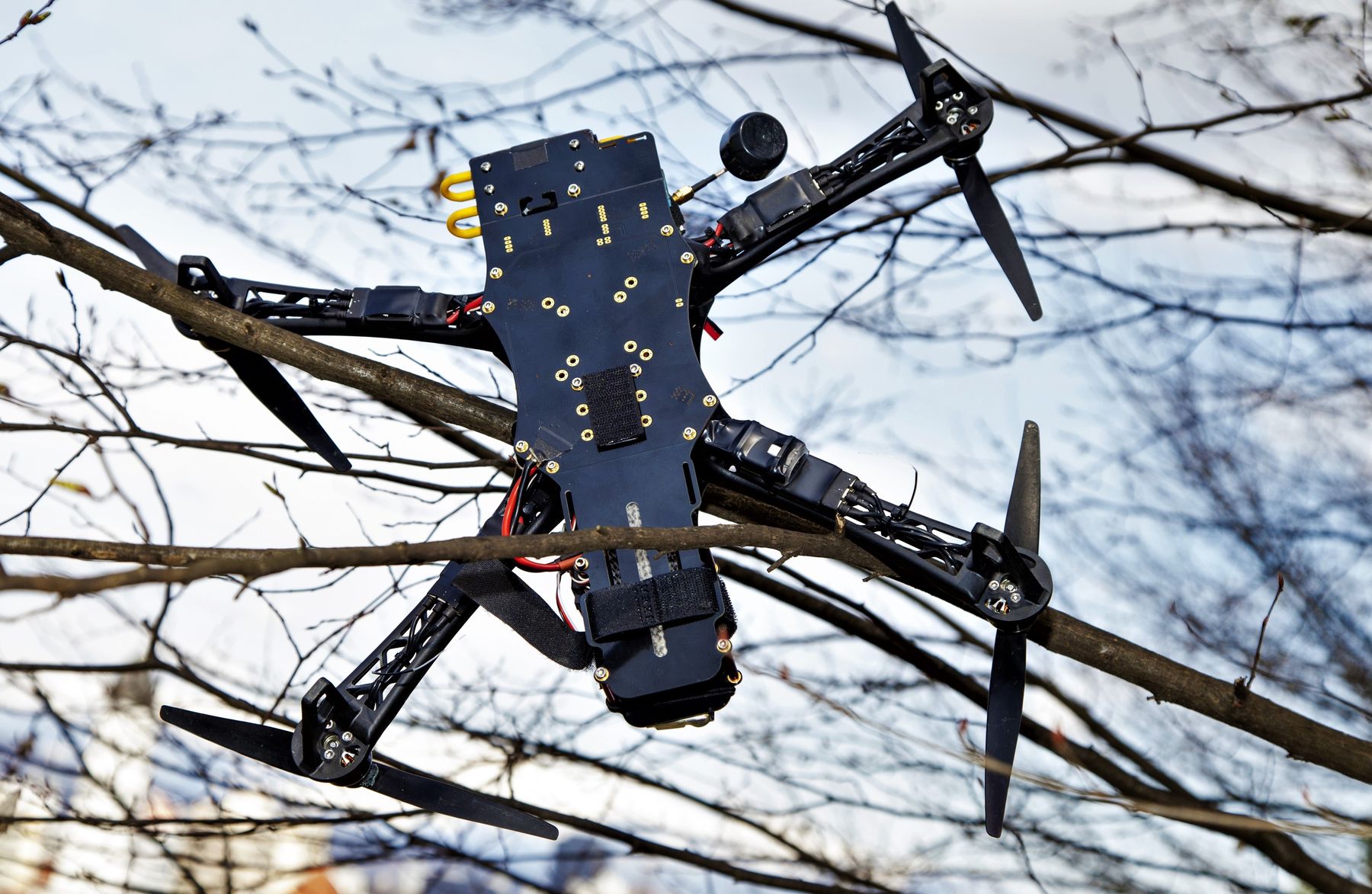
After such an ordeal, it is understandable that you may be frustrated and resort to more desperate forms of rescue. However, it’s important to think rationally.
Many options that come to mind may serve only to cause irreparable damage to the drone, and after all this effort, that is the last thing you would want.
Some ideas to avoid:
-
Knocking It Down
Some websites suggest that you use hard objects or water from a hose to try to knock your drone down from a tree.
If you are close enough to the water hose in your house to reach your drone, plenty of other options would be far better.
However, even if you were to try this option, garden hoses typically don’t have anywhere near the water pressure required to make this work. Besides this, even if they did, the water would run a high risk of damaging the delicate internal circuitry of your drone.
On the flip side, throwing foreign objects on the tree in an attempt to dislodge the drone by force will likely result in it becoming dented, scratched, or even smashed if it falls onto unprotected ground.
Additionally, there is a good chance that you may end up breaking the drone while it’s still there in the tree.
-
Using Another Drone
While the ability to send a remote-controlled piece of tech that can reach the height you need to pull or push the stuck drone from its place may seem like a genius plan, you may want to take a second to remember every sitcom or comedy sketch ever made, as this exact situation has been featured without a doubt.
In trying to use a second drone to dislodge the first one, it seems likely that you will soon find out that the sketch is far less funny when you are on the screen and not in the audience.
Not many things will spoil your mood more than getting your drone stuck in a tree, but getting two of your drones stuck in a tree might be for sure!
The odds that you will merely end up with two stuck or damaged drones are very high and don’t make this proposition worth entertaining.
Bear in mind that there are far too many opportunities for the second drone to become stuck in the same branches as the first or for the rotors to hit a branch and become damaged for this to be worth trying.
The best option is probably not to attempt this method and try the previously recommended ones.
Read more: Best Tracking Drones That Film While Following You
Parting Thoughts
The wave of negative emotions you may feel upon securing your favorite toy tight within the grips of the tree will soon fly away with this conclusive list of options sure to help you retrieve it.
From relatively cheap and simple options that do not require any tools (or money) to more demanding solutions for more complex and stubborn situations, no matter where you find your drone, there is always some method or someone to help.
Besides this, whichever option you choose to attempt, always remember that while you may truly enjoy your drone, and perhaps you have spent a lot of money on it, in the end, it is just an object – it’s not worth it to risk your life or serious injury.
There are many ways to attempt every suggestion in this article in a safe manner, and we’ve outlined tips that can help you ensure that you put your safest foot forward.
Start with the method you find most appropriate, swift, and safe for your individual situation, or you can also combine a few to get the most effective results. But no matter what, “if you don’t succeed at first, try again and again.”
Much of the actions required to get your drone stuck out of a tree will require some creativity. Just remember that your drone isn’t the first ever to be stuck up in a tree, and it is far from the last.
If you are a drone enthusiast, it may be a good idea to craft a kit, as suggested in one of the options above, to have on hand for the next time you find your drone stuck up in a tree.
We hope that you find this article helpful. And lastly, take this situation easily as these methods are sure to keep you flying high!

